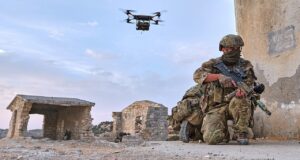July 1st, 2015
By Andrea Kazan – Research Assistant
International humanitarian law (IHL) and international human rights law (IHRL) are two distinct bodies of law. IHL is the law of war and “comprises the rules which, in time of armed conflict, seek to protect people who are not or are no longer taking part in the hostilities, and to restrict the methods and means of warfare employed”. Modern IHL was established in the 19th century and is today comprised of the four Geneva Conventions of 1949, and their Additional Protocols of 1977.
IHRL, on the other hand, seeks to “engage states, primarily to protect certain individual and group rights of those who reside on their territory”. IHRL emerged separately from IHL and it was only in 1966, at the Third Committee of the General Assembly, that a series of binding International Human Rights Laws were adopted: the International Covenant on Economic, Social, and Cultural Rights, and the International Covenant on Civil and Political Rights and its First Optional Protocol.
The application of IHL and IHRL is also quite different. Indeed, IHRL permits states to derogate from some of its provisions in certain cases, while IHL does not hold the same flexibility, and no derogation is permitted at any time. Moreover, even though the obligation to apply both IHL and IHRL is in the hands of each state, the International Criminal Court has the capacity to prosecute cases of breaches of IHL. Nevertheless, most non-state mechanisms used to enforce IHRL are based at a regional level, for example through the European Court of Human Rights.
However, at the end of the 20th century, a new type of organized violence emerged. What Mary Kaldor calls “new wars” involve a blurring of the distinctions between war, organized crime and large-scale violations of human rights and differ from traditional warfare in three main ways: the goal of warfare shifted from geo-political and ideological goals to identity politics; the method of warfare shifted from capturing territory to a drive to “mobilize extremist policies based on fear and hatred”; and the economy of new wars is decentralized, as opposed to the centralized war economies of traditional conflict.
The emergence of this new type of warfare has rendered the straightforward application of IHL difficult. Indeed, IHL was drafted to contain and control traditional wars at a time when hybrid types of warfare were almost non-existent. As a result, IHL is becoming incapable of acting alone for the sake of human security and needs to be supplemented and supported by IHRL for a number of reasons.
Firstly, ‘new wars’ are characterized by the emergence of powerful, armed, non-state actors, which has challenged nation states’ monopoly on the use of force. This, in turn, has affected one of the core components of IHL: the principle of distinction. In fact, with the rise of non-state actors, it has become almost impossible to distinguish between combatants and civilians. In these instances, IHL requires the support of IHRL, and these two bodies of law have to work together to solve ambiguous cases. In the case of Chechnya, for example, the European Court of Human Rights has overlooked the principle of distinction and “directly applied human rights law to the conduct of hostilities in internal armed conflicts”. Moreover, even though Guantanamo Bay prisoners have been classified by the US as “unlawful combatants” and, therefore, have not been seen as subjects to the Geneva Conventions[1] that describes combatants as “regular uniformed troops”[2], most analysts have recognized that “as human beings, they are entitled to a certain minimum level of treatment”[3].
Secondly, acts that were prohibited under traditional 19th and 20th century laws of war, including atrocities against combatants for example, have become “an essential component of the strategies of the new mode of warfare”. This changing mode of warfare has resulted in a considerable increase in the number of civilian casualties: at the beginning of the 20th century, the ratio of military to civilian casualties was 8:1, but by the 1990s the ratio of military to civilian casualties has become 1:8. This is largely because of a change in the strategic status of civilians, the deaths of which are no longer ‘collateral damage’, but a war aim in itself for many actors.
These new methods of warfare have shaken two other essential components of IHL to the core: the principle of proportionality and the principle of military necessity. During the US war in Afghanistan, for example, the 2001 bombing of an Afghan radio station, the July 2002 bombing of a wedding in Uruzgan with no targets in the vicinity, and the employment of 1,210 cluster bombs by allied forces by the end of October 2001[4], are three potential examples of decisions not to apply the principles of proportionality and military necessity in new wars. In these cases as well, IHRL has a role to play to fill the legal gap. Indeed, IHRL played a significant role in the case before the International Criminal Tribunal for former Yugoslavia in Prosecutor v Duško Tadić, where it was stated that “a State-sovereignty-oriented approach has been gradually supplanted by a human-being-oriented approach”.
Thirdly, the temporal and spatial application of IHL poses a problem. IHL should be applied in times of armed conflict. However, in new wars there is a fine line between war and peace. During the Libyan revolution of 2011 for example, it is difficult to pinpoint the exact timing of either the conflict’s beginning, or its evolution from “internal protests and disruption” into an internal armed conflict. Moreover, this debate raises the question: is occupation an armed conflict? Supporting IHL with IHRL provides an opportunity to answer these ambiguous questions. Indeed, in the 2004 Advisory Opinion on the Legal Consequences of the Construction of a Wall in the Occupied Palestinian Territory, the ICJ stated that IHRL should be applied in collaboration with IHL. Terrorist attacks are another example of this temporal and spatial problem. Indeed, the terrorist attacks of 9/11 cannot be considered a traditional international armed conflict in which different nation states engage in mutually armed combat, but it also cannot be considered non-international since it involves international and transnational actors[5]. The need to apply IHRL for human security, therefore, becomes clear. Indeed, even though immediately after 9/11, IHRL was absent from security talks, most notably in Security Council resolution 1373 (2001), in 2003 the Security Council adopted resolution 1456 reaffirming “that terrorism can only be defeated in accordance with the UN Charter and international law, including human rights, refugee and humanitarian law”[6].
In conclusion, even though IHL and IHRL emerged separately as two distinct international law bodies, the emergence of new wars renders their independence obsolete. Indeed, the characteristics of new wars, which are very different than the traditional 19thcentury warfare, require the existence of a constant interplay between IHL and IHRL for the sake of human security.
[1] Lowe, Vaughan (2007) ‘International Law’, Oxford, Oxford University Press
[2]Brownlie, Ian (2008) ‘Principles of Public International Law’, Oxford, Oxford University Press
[3] Lowe, Vaughan (2007) ‘International Law’, Oxford, Oxford University Press
[4] Duffy, Helen (2005) ‘The War on Terror and the Framework of International Law’, Chapter 6, Cambridge
[5] Duffy, Helen (2005) ‘The War on Terror and the Framework of International Law’, Chapter 6, Cambridge
[6] Duffy, Helen (2005) ‘The War on Terror and the Framework of International Law’, Chapter 6, Cambridge
 Human Security Centre Human Rights and International Security Research
Human Security Centre Human Rights and International Security Research



